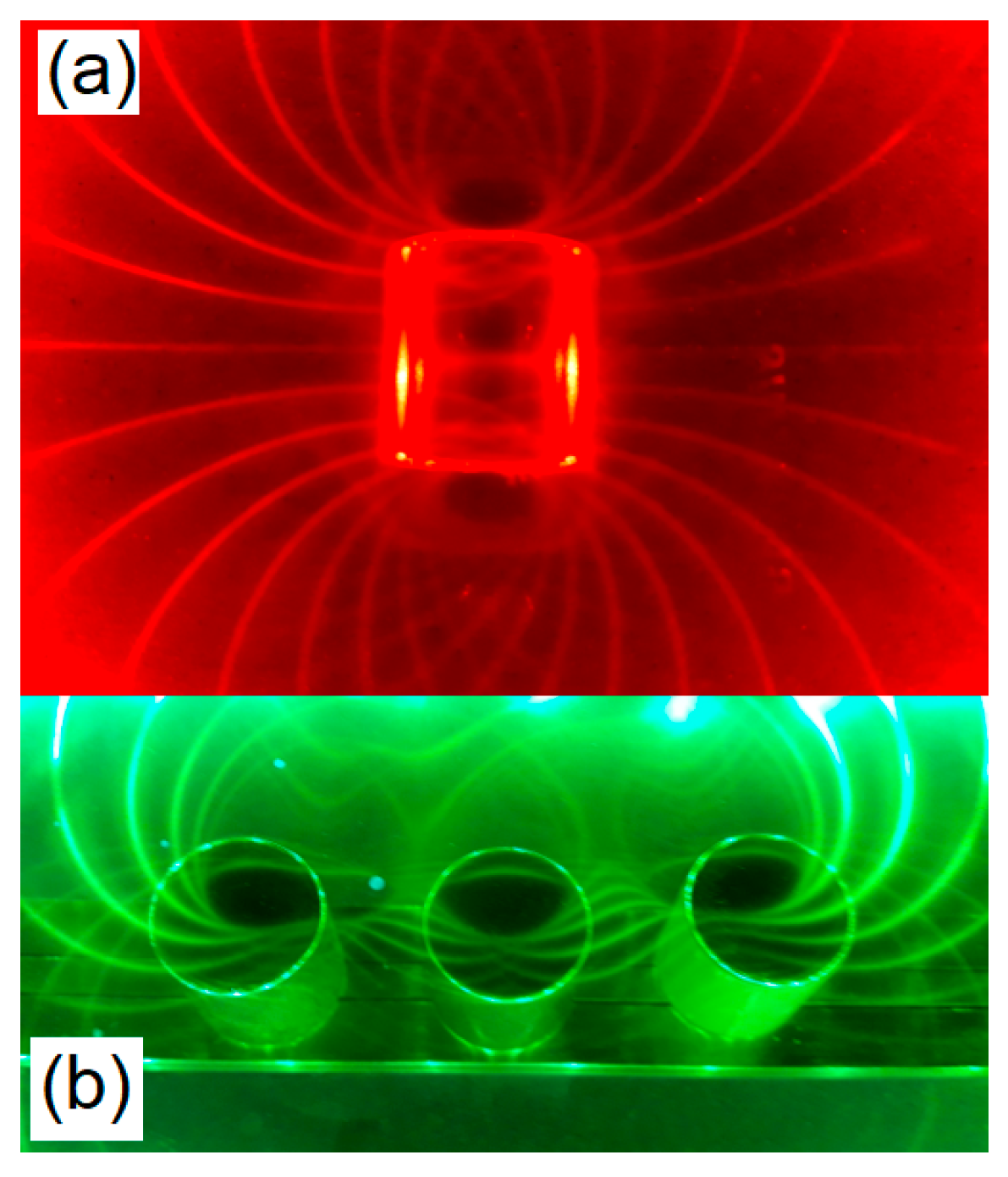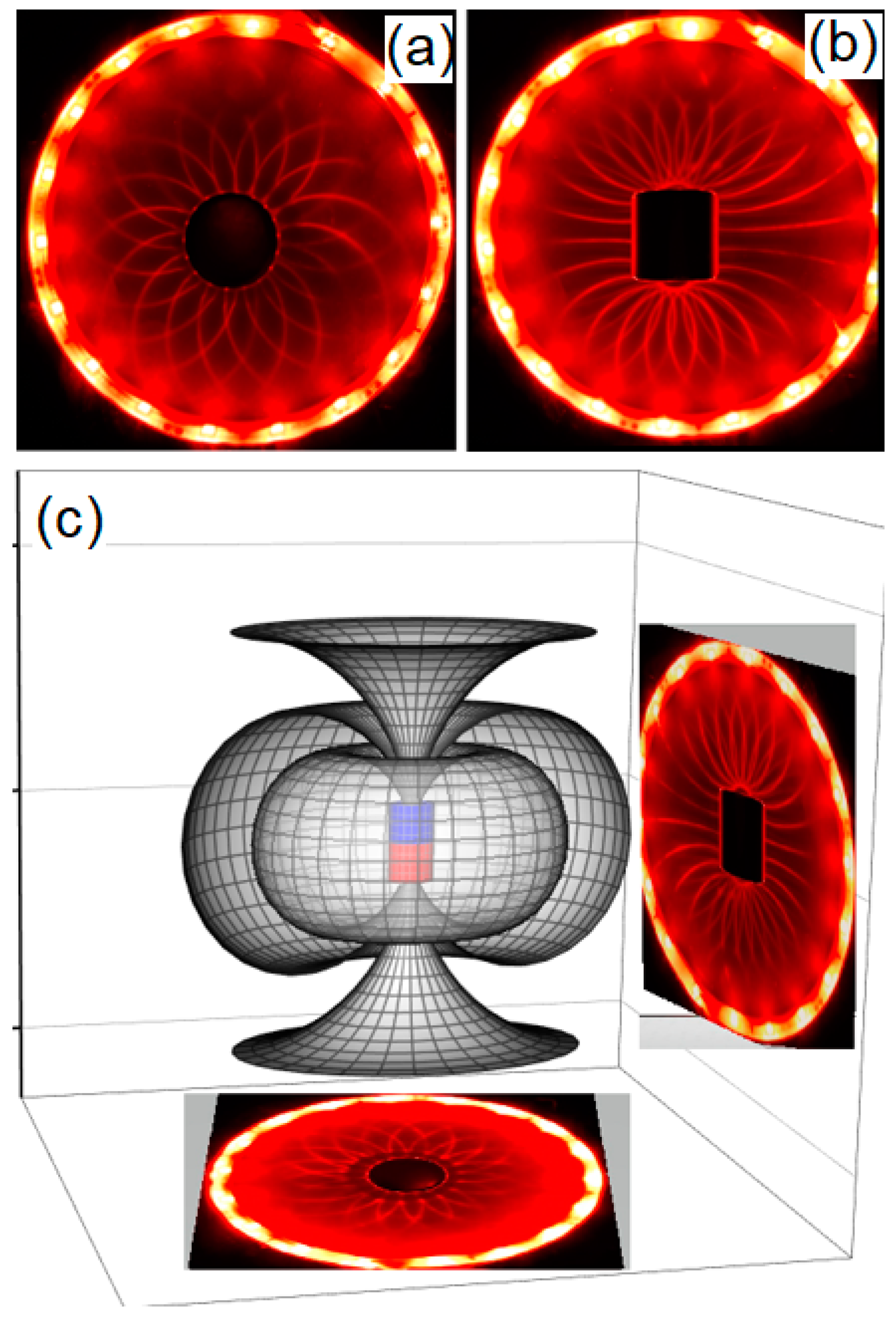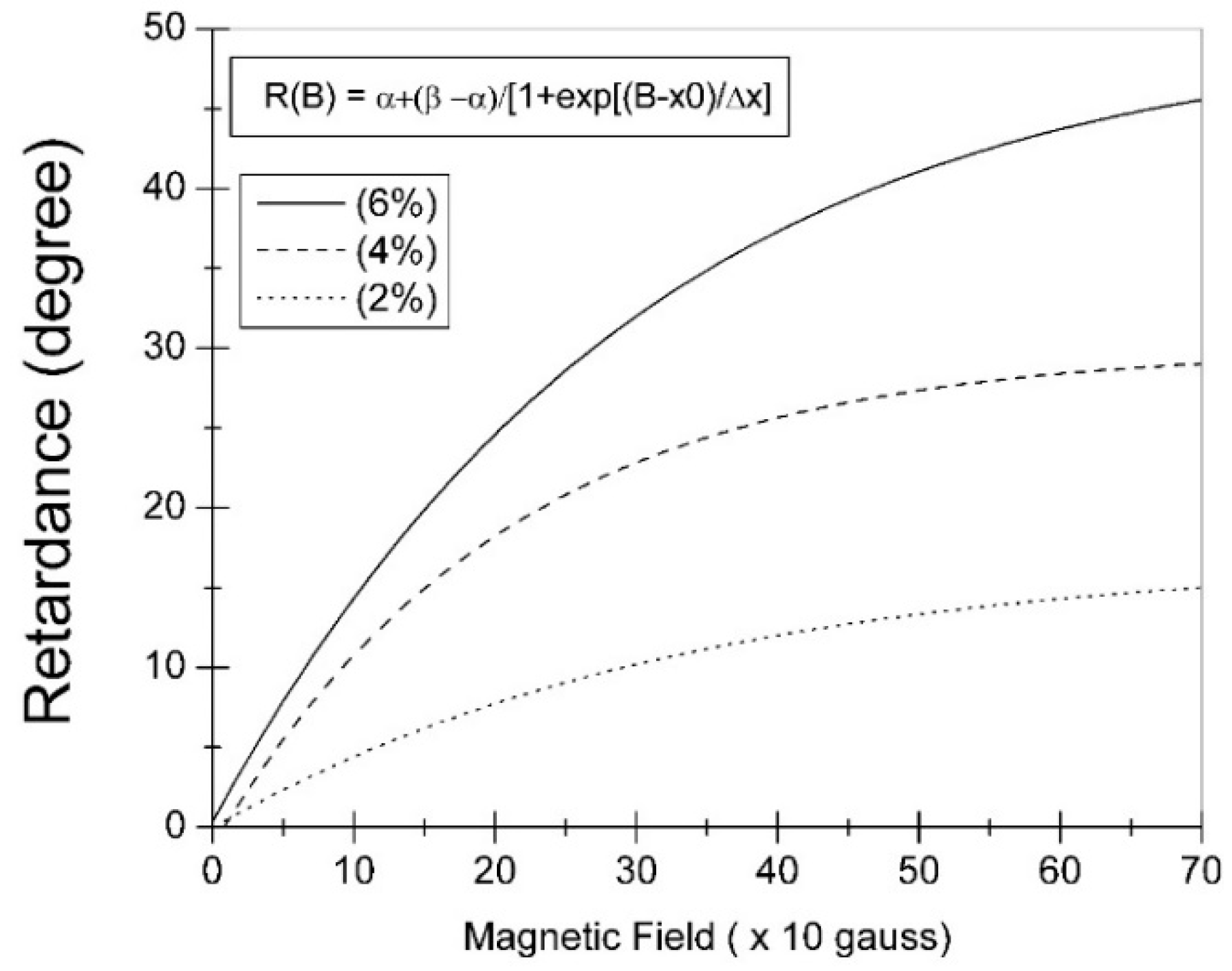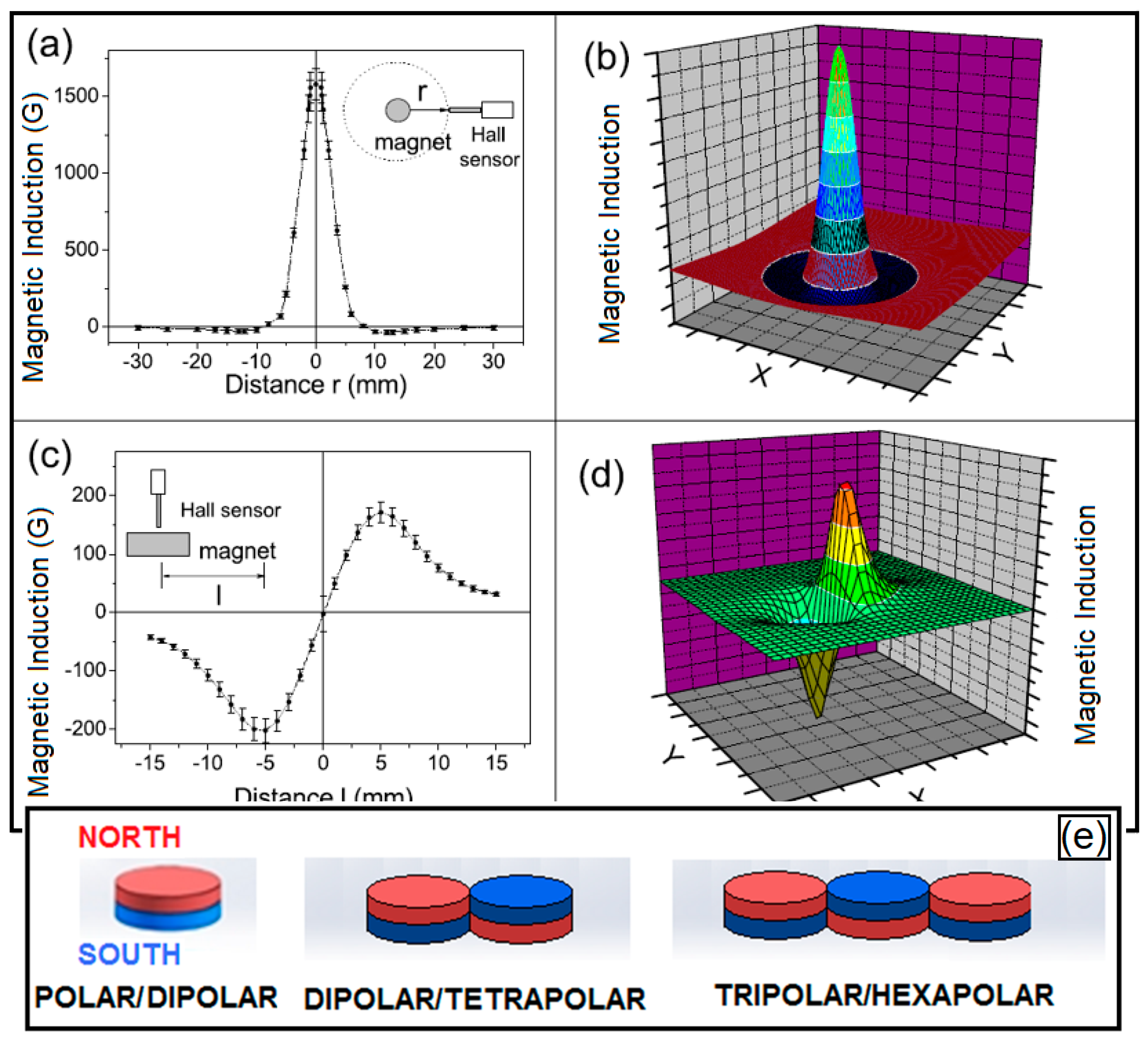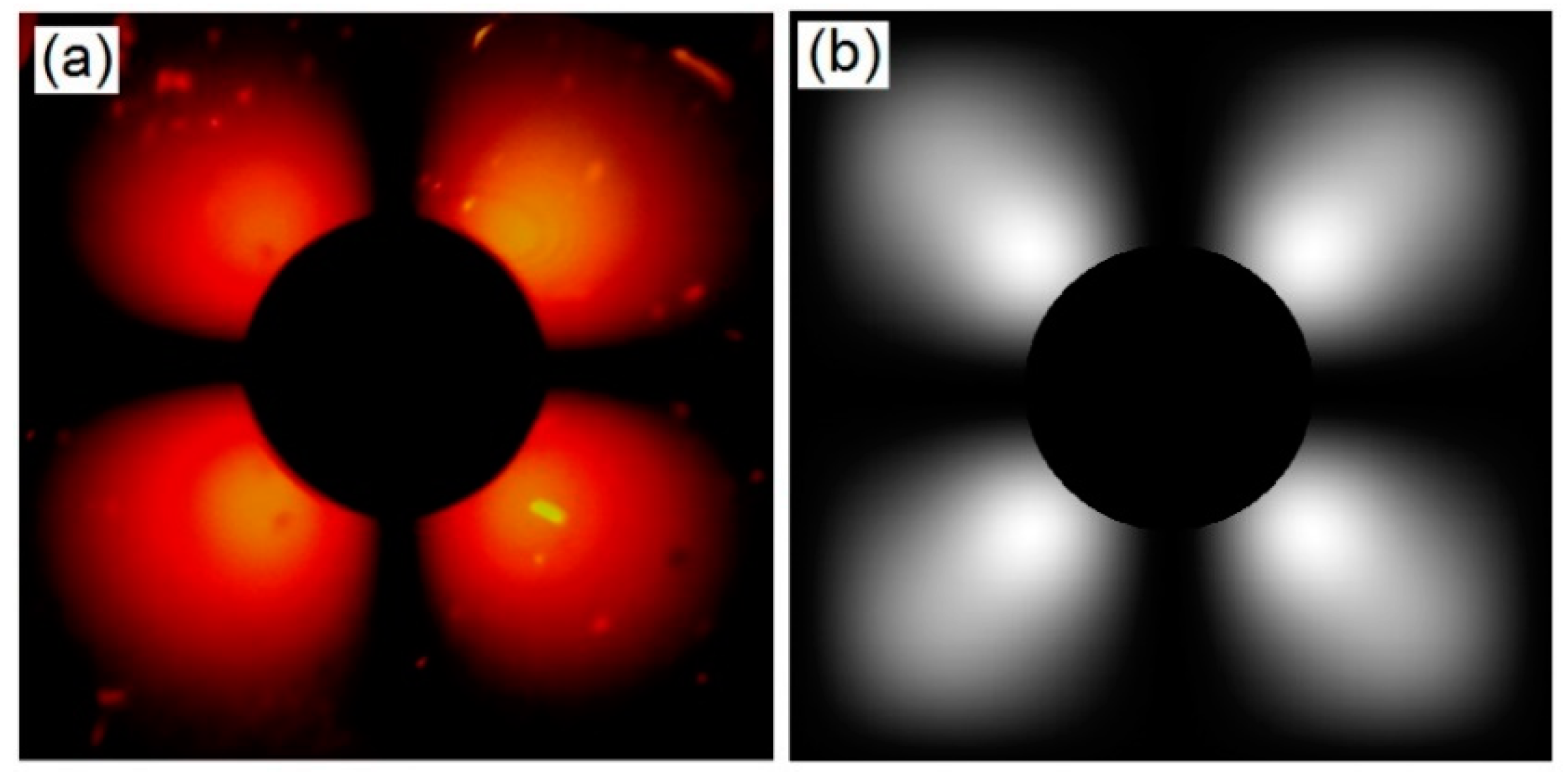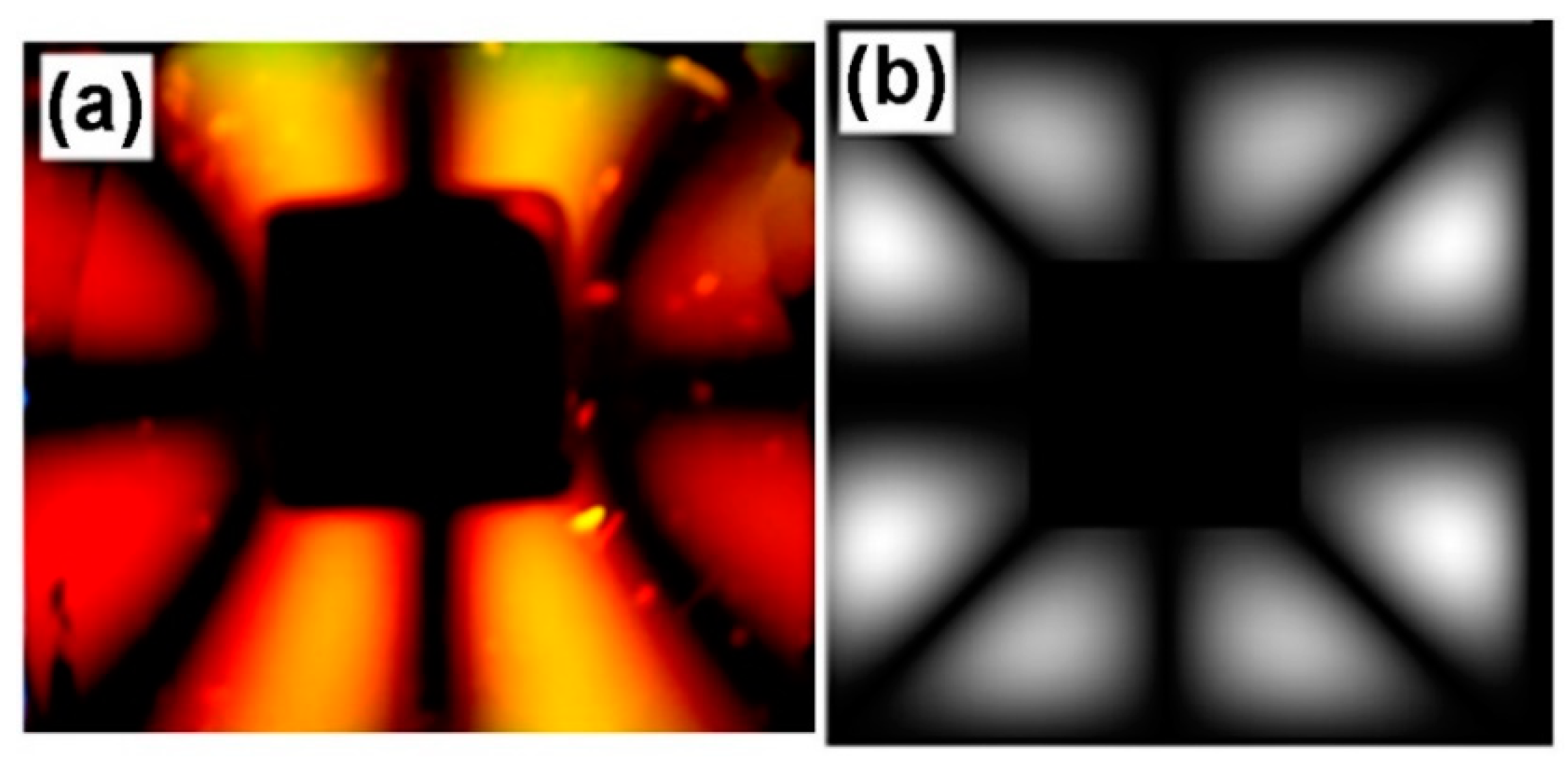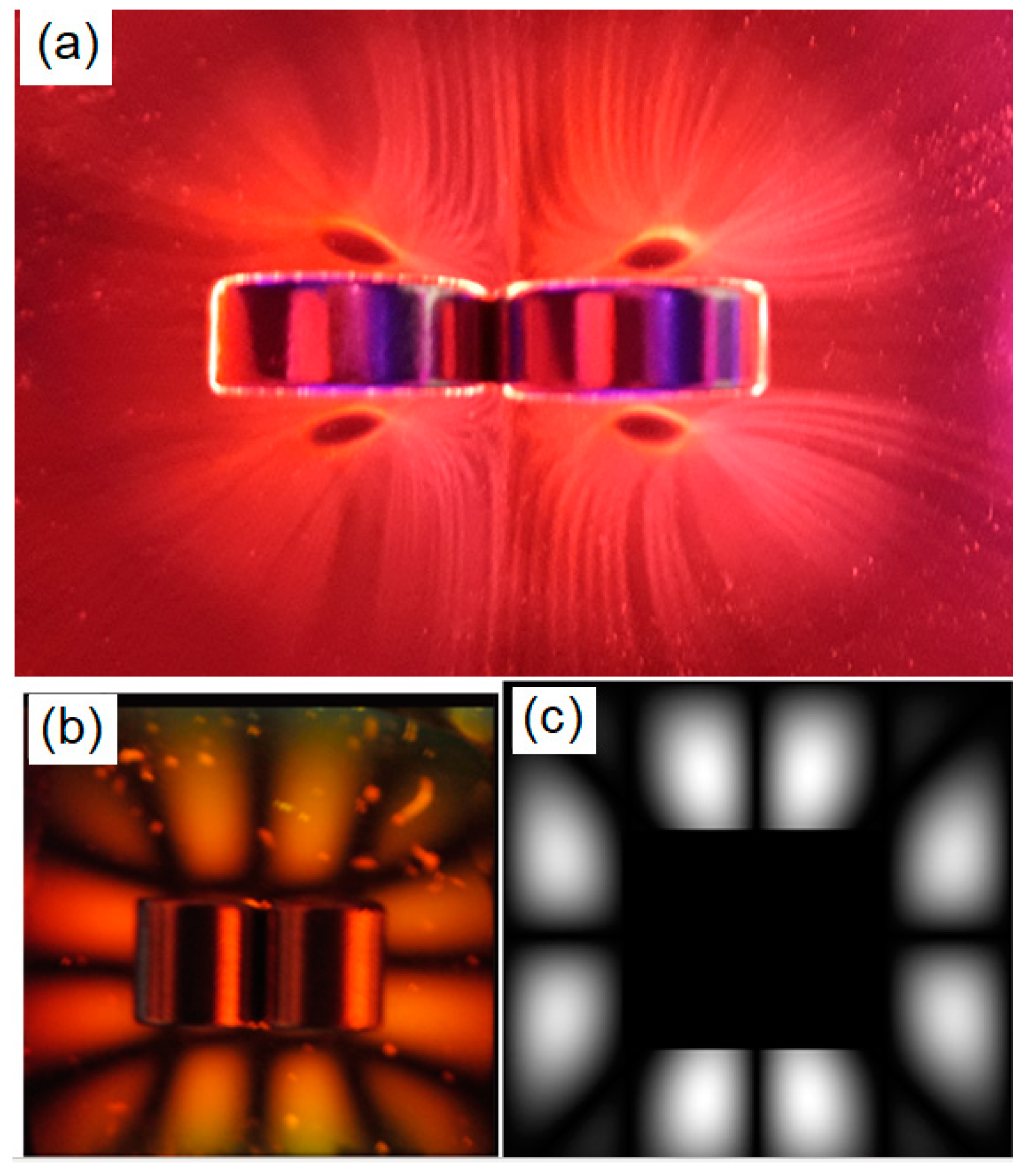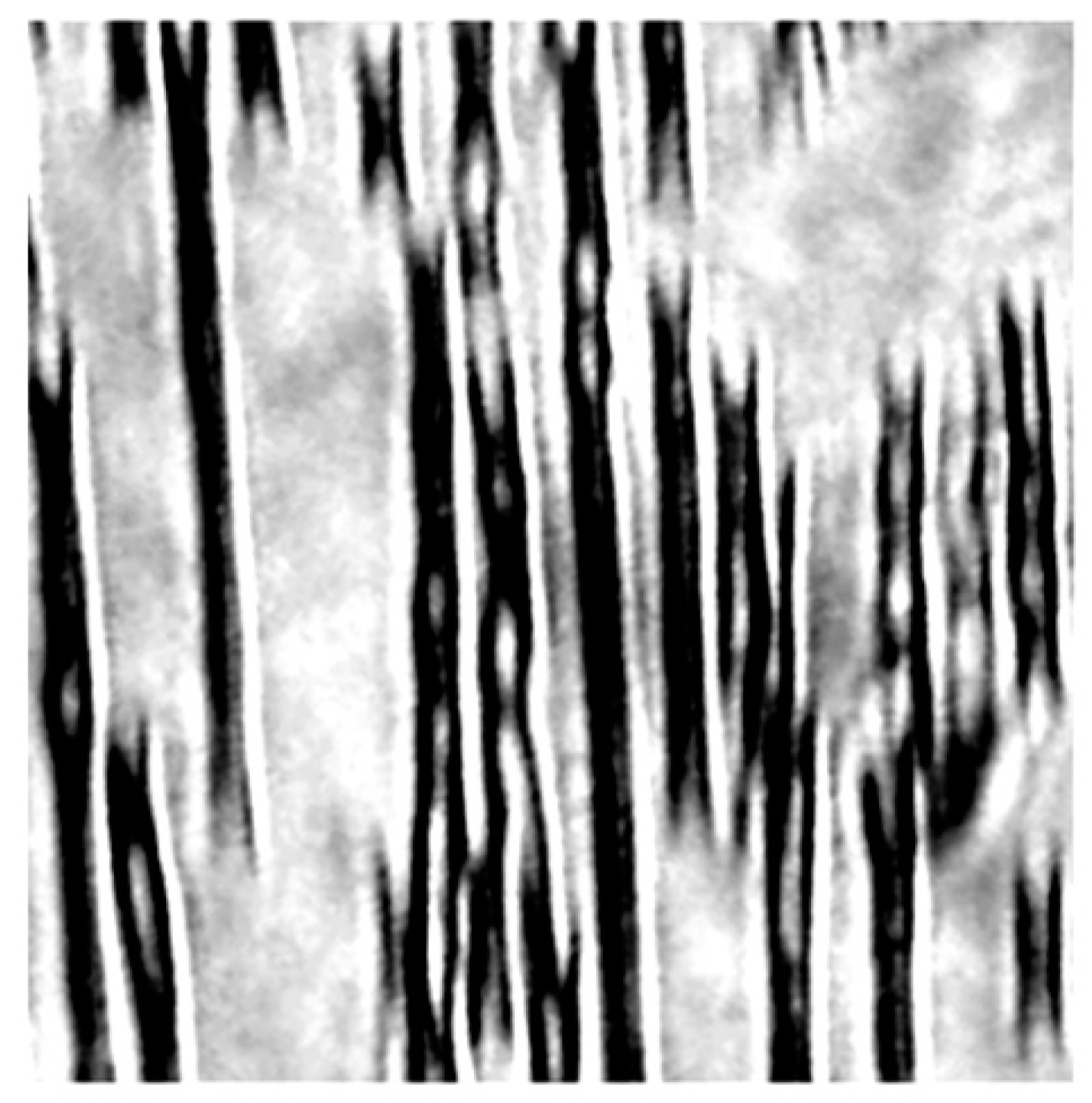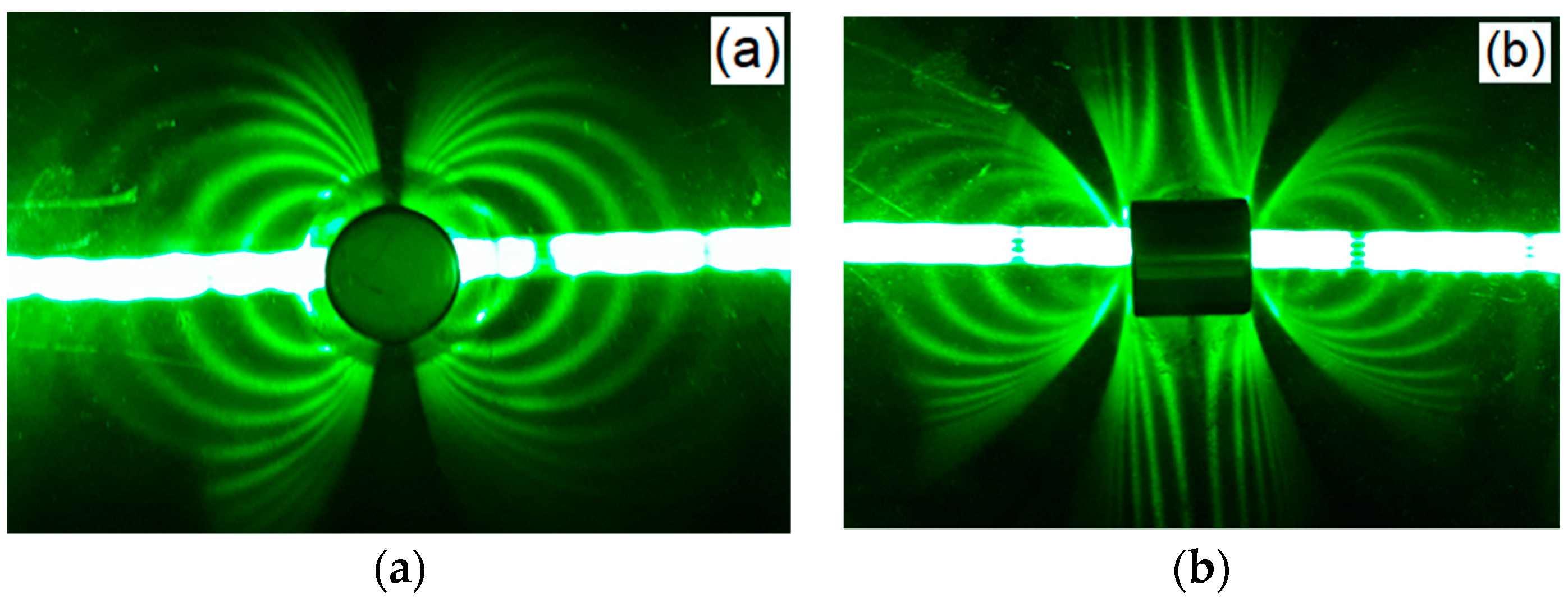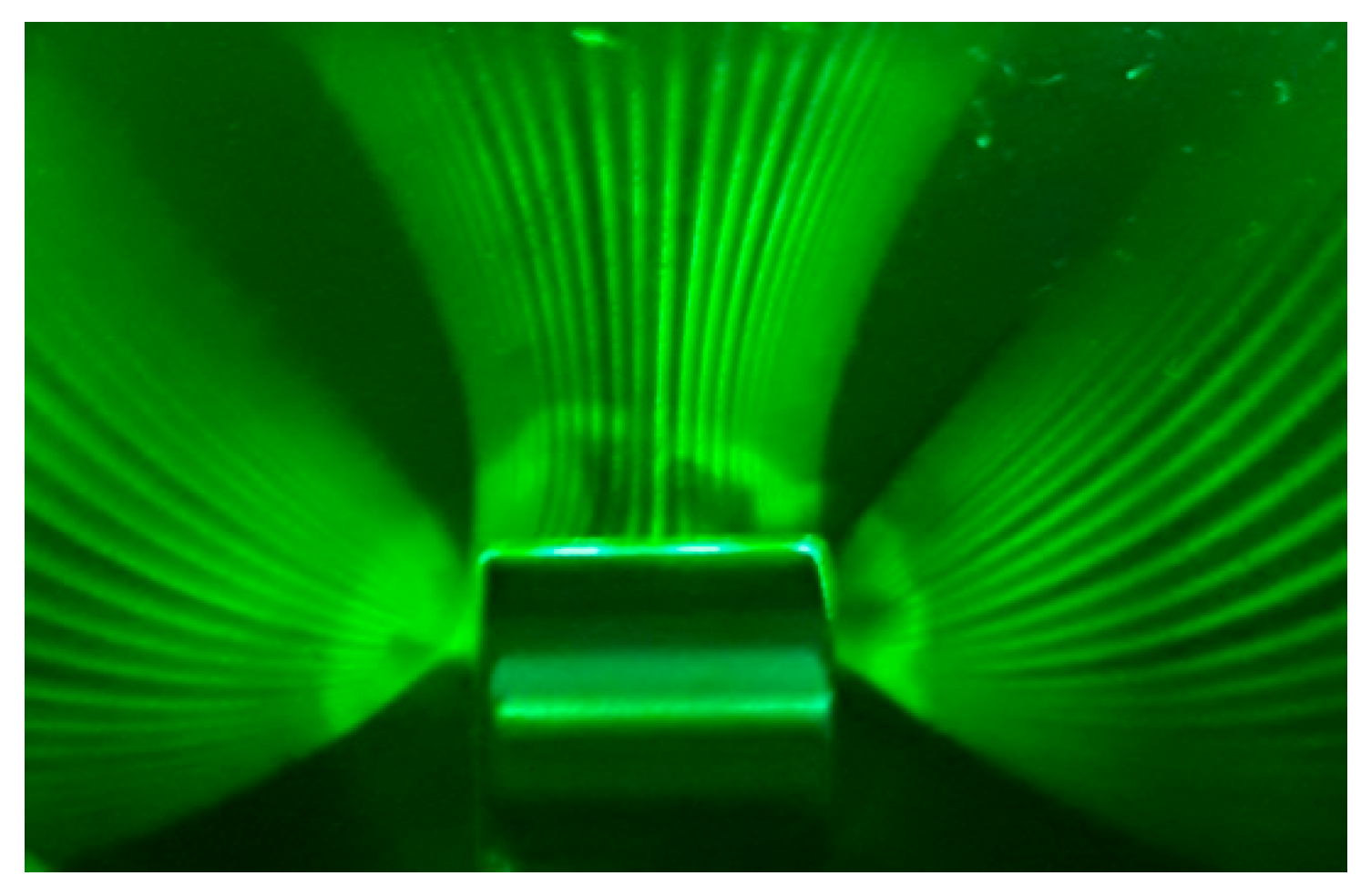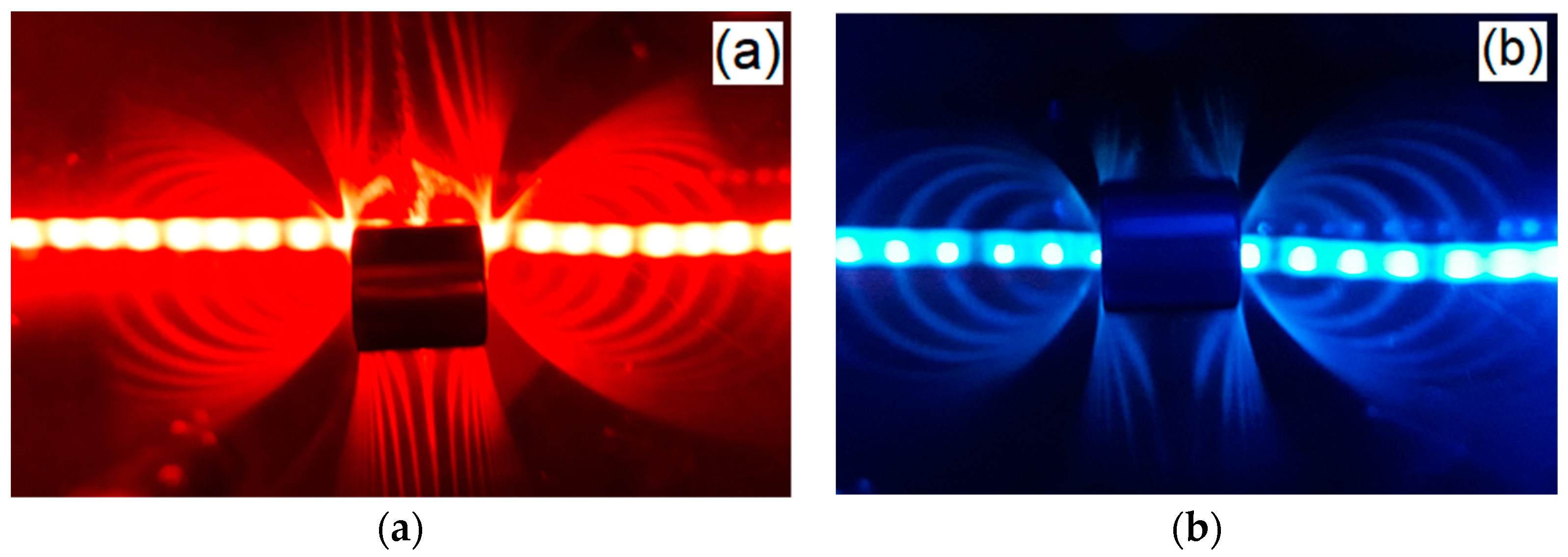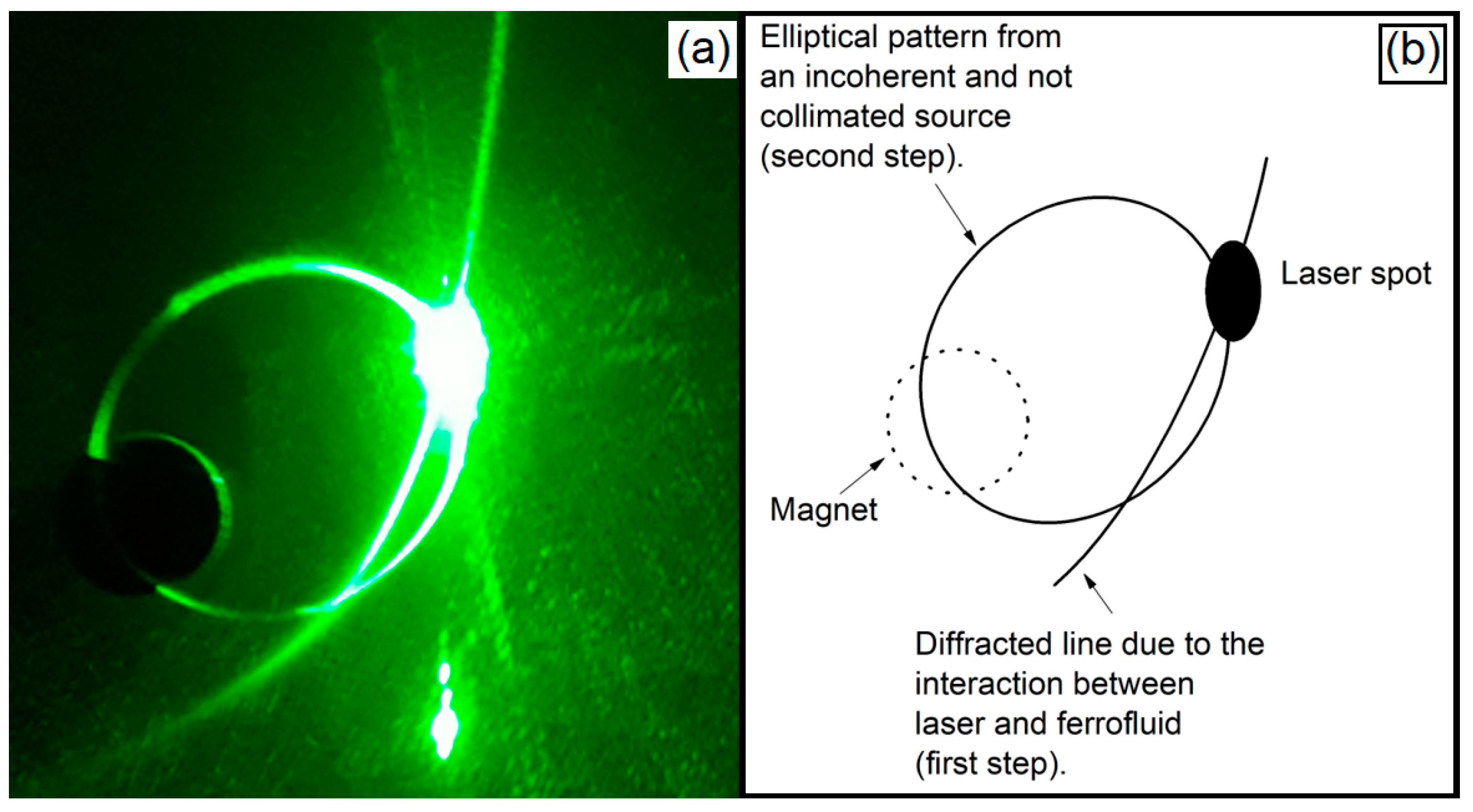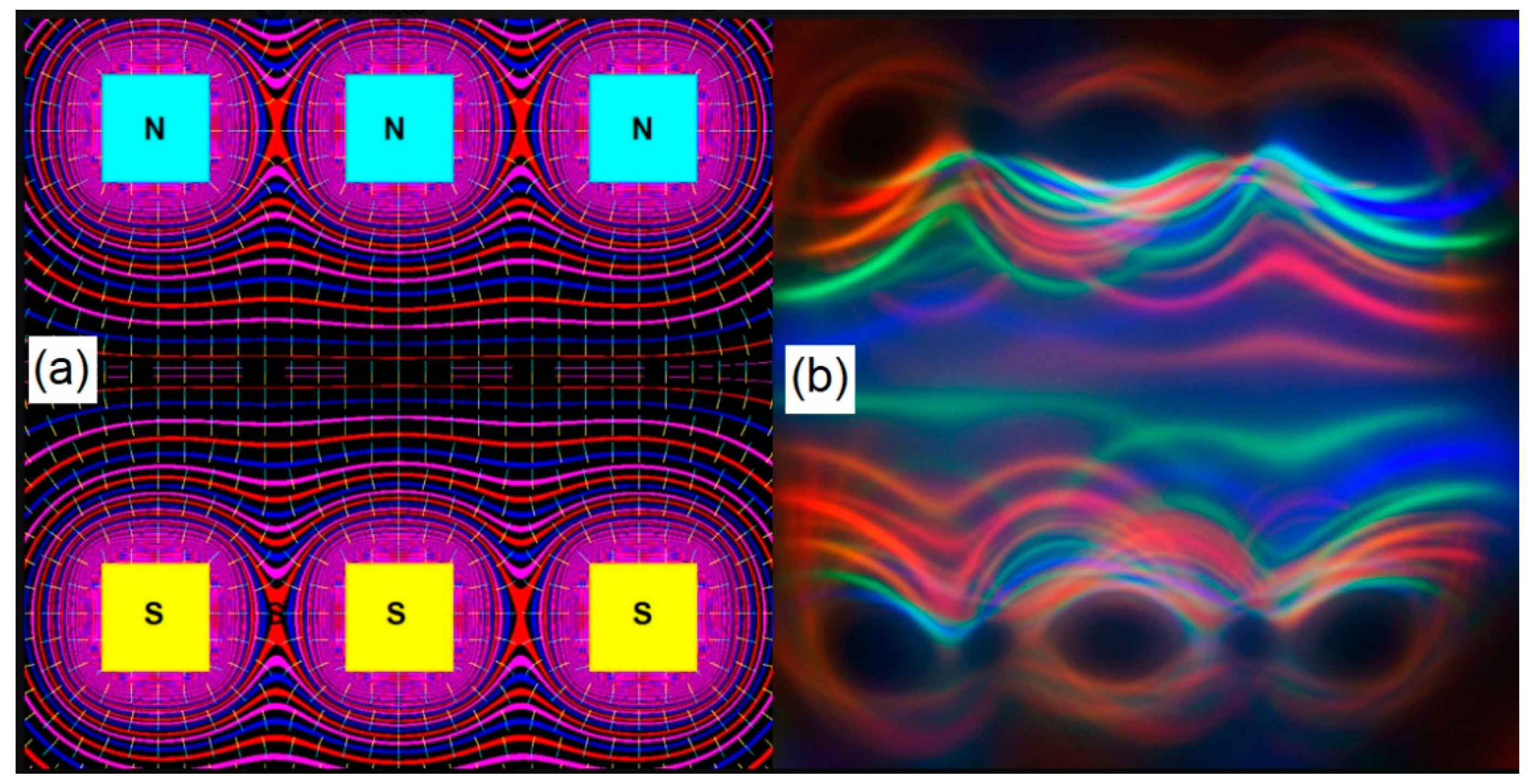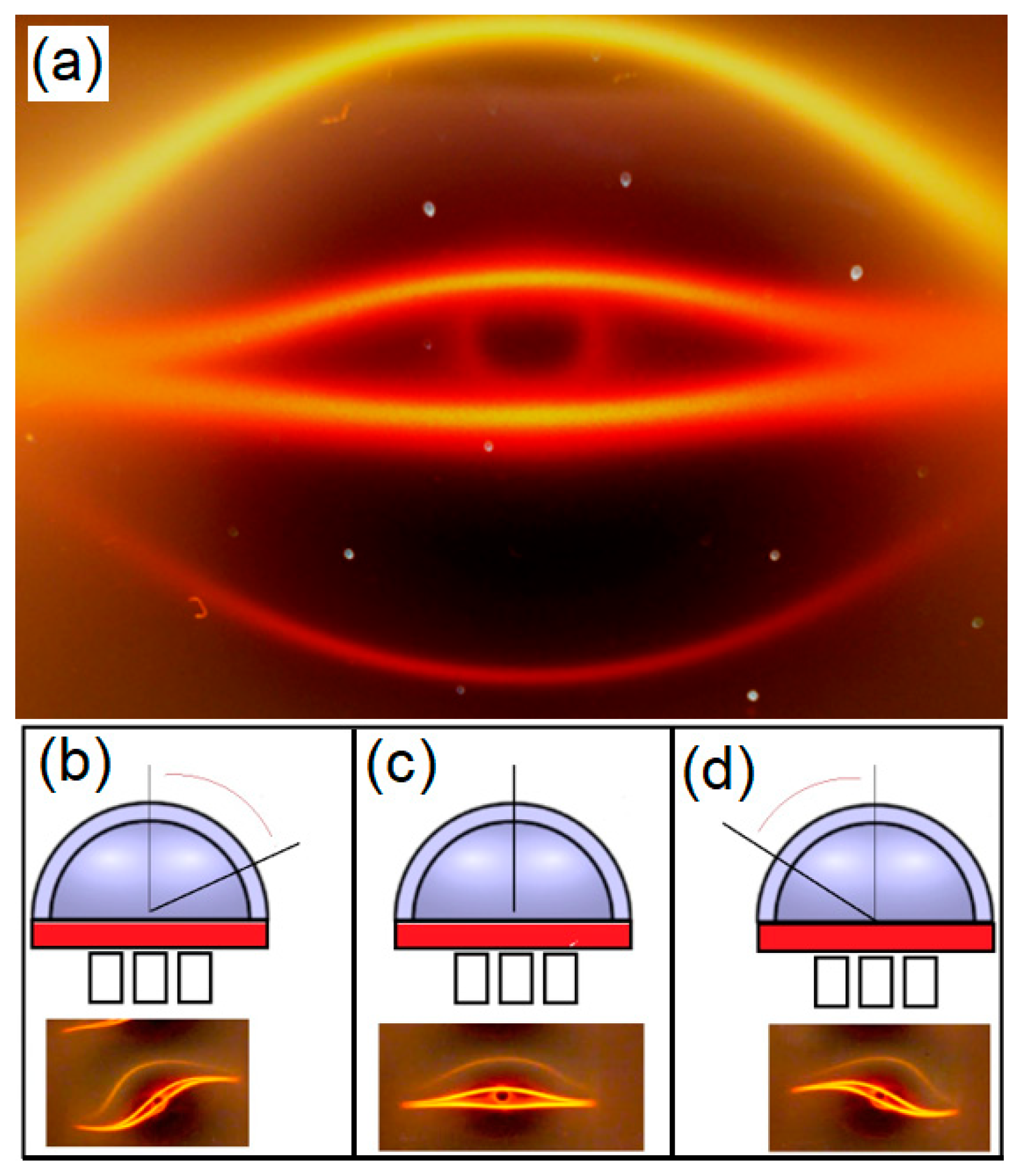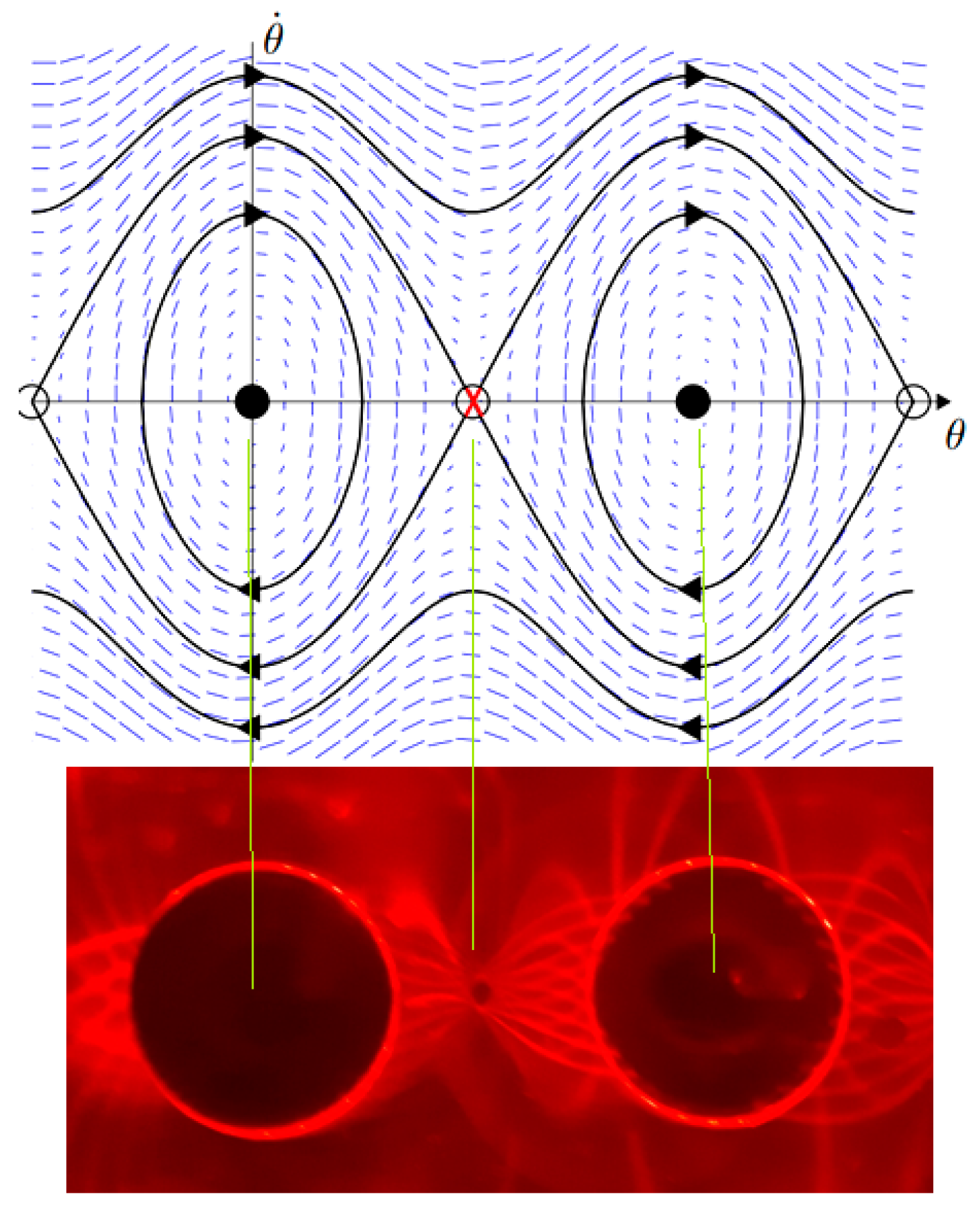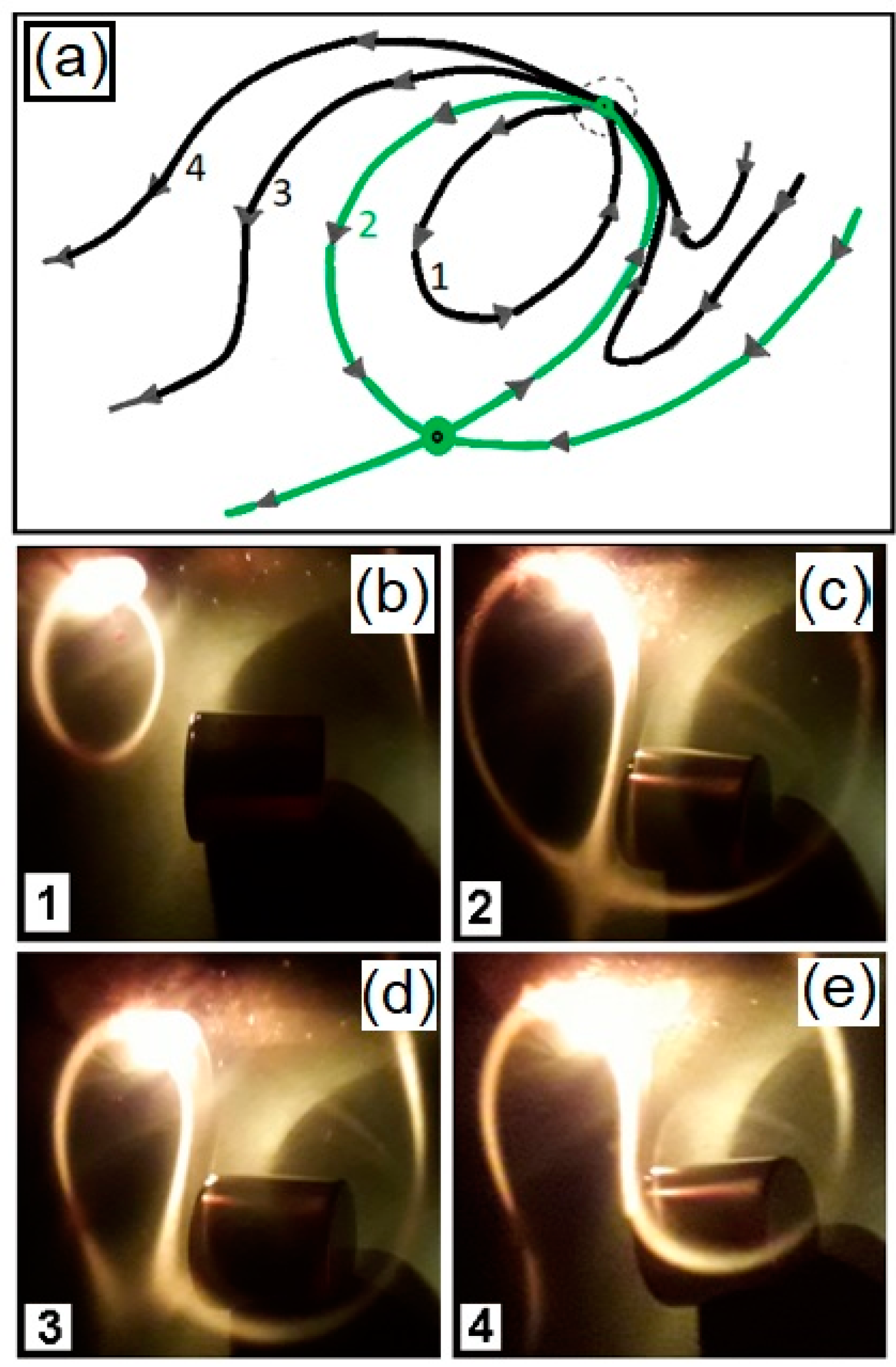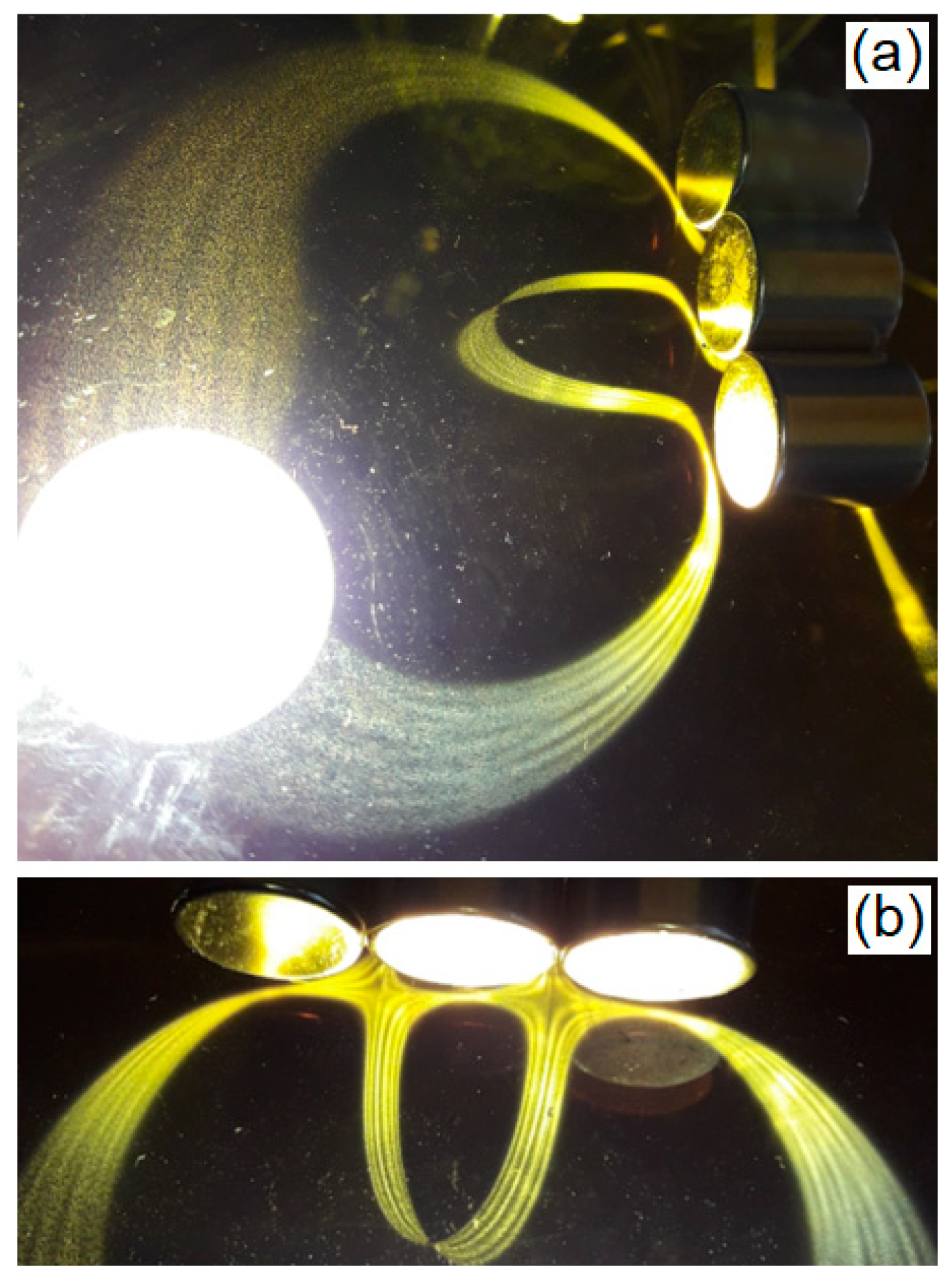3.1. Light Polarization in Thin Film and Magnetic Contour Patterns
At very low fields (less than 1 G), the ferrofluids are isotropic, and light passes through the Ferrolens with almost no scattering because the magnetic nanoparticles behave as a single domain particle in a state of Brownian motion. Increasing the intensity of the magnetic field (around 500 G), approaching a magnet in the polar configuration 6 mm from the top of the Ferrolens, there are anisotropic effects, because aggregations of magnetic elongated particles along the field direction happen due to the strong interparticle interactions [
10,
11,
12], like the macroscopic patterns of iron filings around a magnet. The light polarization patterns obtained from the experiment can be observed in
Figure 5,
Figure 6 and
Figure 7 for some configurations of permanent magnets.
In
Figure 5a, the Ferrolens is generating patterns for the case of polar configuration obtained from a magnet facing the Ferrolens, with the magnetic field represented previously in
Figure 4b measuring the magnetic field in the plane
X-Y. In
Figure 6a there is the image of light polarization of the dipolar configuration of the magnetic field from
Figure 4d. In
Figure 7, we are presenting the case of the quadrupolar configuration, with the light pattern obtained without polarizers in
Figure 7a with two magnets at the center of the figure. We can see the light polarization pattern in
Figure 7b. In
Figure 5b,
Figure 6b and
Figure 7c we are presenting the simulations of the light polarization of the Ferrolens in the presence of the respective magnetic field configurations. The main aspects of these simulations are discussed below.
By inspection, we have observed that some of these properties of light polarization are related to multiple diffraction problems and pattern formation. If
U(x,y) and
U′(x′,y′) represent the complex amplitudes of light over the surfaces of the Ferrolens, then by applying the Fresnel–Kirchhoff diffraction theory [
13] we can write
in which
r = [d2 + (x′-x)2 + (y′ − y)2]1/2 and
cos θ = d/r. Without the ferrofluid, the two functions will become identical, but in the presence of the diffraction grating formed by the ferrofluid subjected to the magnetic field, there is a constant factor γ. In this case
Although accurate solutions of this cavity problem are quite involved, it is possible to find a simple approximation by employing the same procedure as that of the Fraunhofer diffraction case, the function
U(x,y) is its own Fourier transform. The simplest of such functions is the Gaussian, and the more general functions that are their own Fourier transforms are products of Hermite polynomials
Hp and
Hq:
In the presence of the external magnetic field configurations, we have observed the existence of some typical patterns. The observed pattern suggests a resemblance of the polarimetry of Ferrolens with the concept of spatial mode of Equation (3) and other hypergeometric polynomials empirically. We have approximated the intensity of light polarization
I observed for magnetic field
B [
2,
10] as
in which
B0 is the maximal intensity of the magnetic field,
Hm(x) and
Hn(y) are the spatial derivatives of the magnetic field functions in the
x-axis and
y-axis respectively.
I(x,y,z) is the light intensity directly observed from the Ferrolens with two crossed polarizers. These solutions are represented in the simulations of
Figure 5b,
Figure 6b and
Figure 7c.
It is interesting to note the existence of the combination of diffraction and interference in this system. When a laser beam passes through this magnetic fluid placed in a magnetic field, it undergoes diffraction, producing characteristic patterns such as the jumping laser dogs [
2]. The magneto-optical properties of this kind of combination of diffraction and interference was extensively studied by Philip et al. [
4], summarized by the statement that the reason for the formation of curved light lines on the scattered pattern can be explained by considering scattering of light by cylinders and evaluating the scattered electromagnetic field from a cylindrical surface. The light diffracted by a spatial grating of magnetic chains is an integral sum of diffraction events from individual chains, and the observed patterns can be interpreted as a combination of diffraction and interference [
10]. For magnetic fields intensities around 500 G, the formation of light patterns become sharper, and this behavior indicates the formation of smoothly surfaced columns. Some examples of these columns (nanoneedles) obtained from our experiment are given in
Figure 8. For more details of this kind of agglomeration see Ref. [
14].
The study of these agglomerates can be done in Ferrolens type devices to observe their evolution of biocompatible materials in the presence of magnetic fields, simulating the effects of these materials in conditions like those found in living tissues, where the flow is restricted due to the size of the vessels through which fluids flow, such as blood [
7,
8].
These concepts suggest a possible explanation for the magnetic contours observed in the Ferrolens based on the idea of magnetic potential. For the case of a magnetic scalar potential
Vm, the magnets can be modeled as two magnetic charges
Mc producing a magnetic dipole with [
3]:
in which
rn and
rs is the position of poles north and south, respectively, and
μ is the magnetic constant. The nanoparticles create a structure very similar to a diffracting grating from the influence of the orientation of a magnetic field. The light diffracted by the ferrofluids grating seemed to follow isopotential lines of this scalar field, having the light source as the origin of the light line, because each diffraction line is perpendicular to the scatterer. Starting with the case of the polar magnet configuration by considering (
rs infinity), which reduces the magnetic potential to the case:
This case gives us the representation of equipotential lines surrounding the pole of the magnet forming concentric circles. Since the magnitude of the magnetic potential decreases as 1/r with the distance from the source, lines representing equal jumps in potential are spaced closer together nearer to the north pole of the magnet and spaced farther apart away from this magnet pole. These concentric circles of the magnetic field form because of the symmetry of the magnetic pole, and hence the radial symmetry of the field suggested by the polar configuration of Equation (6).
The relationship between the diffracted lines and the magnetic potential is clear when considering a single dimension. In the one-dimensional case,
r =
x, so that
Vm =
constant/
x. Hence the vector associated with light lines
D and the magnetic scalar potential
V is
In other words, this relation means that the strength of the diffracted lines at any point in space is the rate of the change of the magnetic potential over space. If the magnetic potential changes significantly for a given distance, the diffracted line is strong, but if the magnetic potential changes only by a small amount at the same distance, the diffracted line is less intense. In addition to this, we have observed that these diffracted lines depend on the physical properties of the light source, such as polarization, states of collimation and intensity. Thus, we say that the diffracted lines mimic the gradient of the magnetic potential.
In this way, the magnetic contours are analogous to the orbits of dynamical systems, because these contours are associated to a vector field, and the trajectories of these orbits are obtained by the diffracted light, which consists of light patterns irradiated from the liquid film, and these light patterns can be related to some magneto-optical effects, depending on the relative position of the viewer and the light source. In
Figure 9 we present the top view of two light patterns obtained using a straight line of LED’s, in the case of a polar configuration in
Figure 9a and a dipolar configuration in
Figure 9b, for the same straight line of LED’s. To exemplify the dependence of the position of the light source, in the case of the dipolar configuration in
Figure 9b, we are presenting the pattern of
Figure 10, the sequence of curved light lines from placing a straight line of LEDs far from the magnet.
The general pattern of the orbits does not depend on the wavelength of the light source, as it can be seen in
Figure 11a,b for the same case of the dipolar configuration of
Figure 9b, with light colors red and blue. In all these cases the light patterns do not cross each other, like the case of equipotential lines oriented by the magnetic field and the source of light as well.
To reinforce the effect of collimated and uncollimated light source in the Ferrolens, we are presenting the case of light diffraction by transmission in
Figure 12, which occurs when we used the laser beam (a coherent and collimated source of light) passing through the Ferrolens, while the formation of elliptical light patterns in the plane of the Ferrolens is caused by the light scattering of non-collimated light, forming patterns in a two-step process. This can be observed simultaneously in
Figure 12, in which the first step is the diffraction of the green laser light through the Ferrolens in the presence of a magnetic field, projecting a curved line in the screen, with an intense light spot obtained due to the direct projection of the laser. The next step is obtained by the light spot of the laser hitting the screen, changing it to an uncollimated light source. The elliptical pattern is the result of this light spot affected by the magnetic field, or any kind of incoherent and not collimated light placed behind the Ferrolens, such as an LED, or an incandescent light. In
Figure 13, we have a comparison between a simulation of the vector
D and the light pattern obtained with Ferrolens, using various light sources of different colors. In this figure, we can observe that the phenomenon of line crossing is associated with different sources of light, as discussed previously.
3.2. Light Patterns and Chirality
There is another interesting phenomenon associated with magnetochiral pattern of
Figure 14, in which we have used three magnets to create this pattern, in a tripolar configuration south-north-south pole.
Figure 14a is the top view of this pattern, and in
Figure 14c, we can see the diagram of the experiment. For different angles of observation, this pattern suffers a distortion, as it is shown in the diagrams of
Figure 14b,d. The image of
Figure 14b is a reflection of
Figure 14d, and it cannot be superposed to it. By definition, a system is chiral if it is distinguishable from its mirror image. A possible explanation for this effect could be the existence of magnetochiral assembly of nanoparticles affecting the light patterns. The ferrofluid undergoes structural transitions under external magnetic field, according to Singh et al. [
12], because nanoscale particles could self-assemble into structures with unique spatial arrangements, such as helical-like structures due to the interplay of magnetic dipole-dipole and van der Walls interactions, as well as some entropic forces, depending on the geometry of the nanoparticles, leading to anisotropic effects. Even spherical particles may have angular dependences in their interactions if there is an internal direction defined within particles. The permanent magnetic dipole moment of the nanoparticles responds to an external magnetic field, and the interaction between ferromagnetic particles depends on the angle that the interparticle vector makes with the external field. The consequence of this anisotropy is the emergence of optical chiral structures. According to Witten [
15], the dipolar interaction energy (
E1,2) in a fluid of dipoles with magnetic moments
μ1 and
μ2 is given by
The strength of the dipolar interaction between particles may be expressed in terms of a dimensionless coupling constant l = Ed(i,j)/kbT, with kbT representing the thermal interaction. The dipolar interaction influences the organization of the rod structures at ambient temperatures, where l is close to 1. The magnetic perturbations twist the structure of nanoneedles, and this twist could be the source of this magnetochiral effect.
